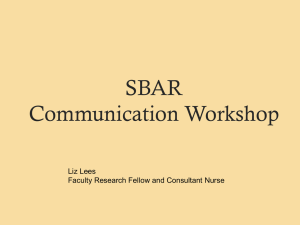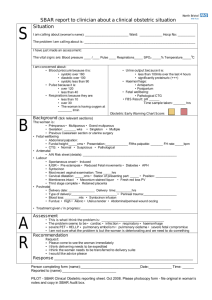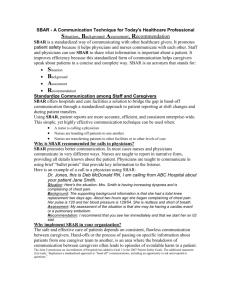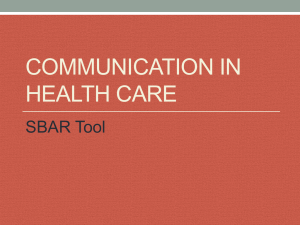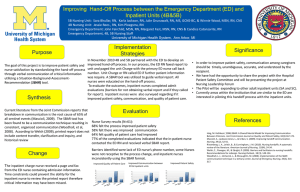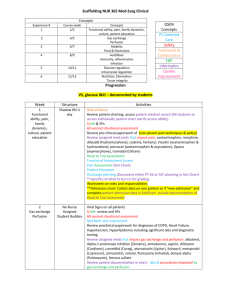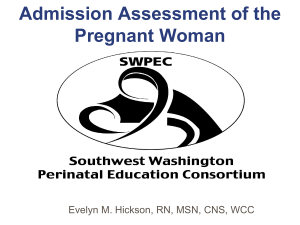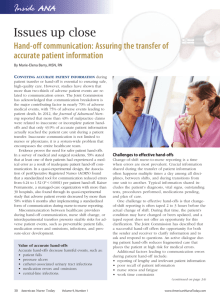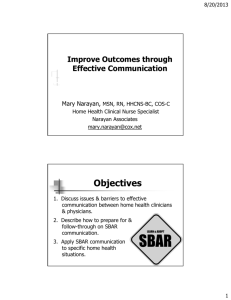SBAR Interprofessional Communication in Healthcare
advertisement
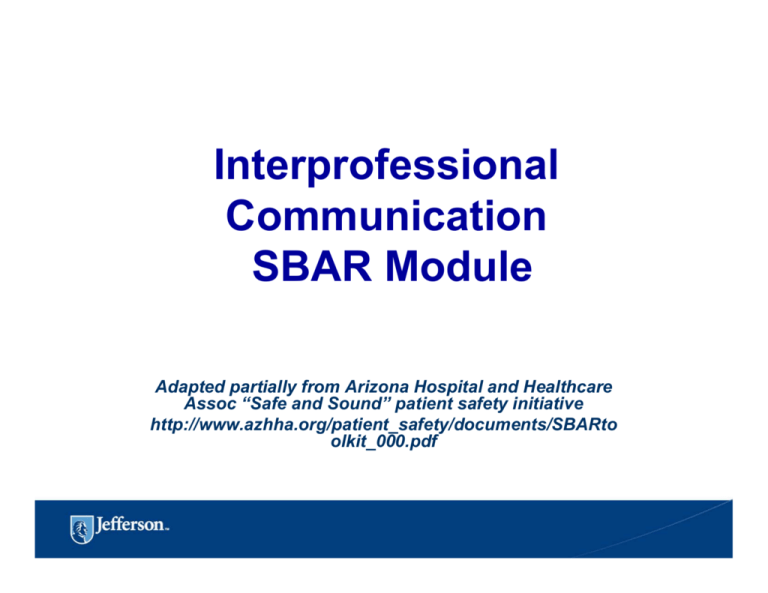
Interprofessional Communication SBAR Module Adapted partially from Arizona Hospital and Healthcare Assoc “Safe and Sound” patient safety initiative http://www.azhha.org/patient_safety/documents/SBARto olkit_000.pdf Communication by G Love & Special Sauce Blues and hip hop band originally from Philadelphia, PA I wanna know what your sayin' I wanna know what it's all about I want you to spell it out for me No I'm not a mind reader No I'm not a heart beater No I don't have ESP C-O-M-M-U-N-I-C-A-T... I-O-N (c'mon let's sing it now) communication, communication, communication with me • Objectives of session At the end of the session, participants will be able to: 1. Discuss the benefits of interprofessional communication and collaboration in enhancing patient care safety and outcomes. 2. Identify the SBAR method as an evidence based model. 3. Apply a communication technique using case scenarios. Communication among health professionals • What are some “barriers” to good communication in the health care setting? • What are some “facilitators” to good communication in the health care setting? BACKGROUND • Some studies indicate that 70-80% of medical errors are related to interpersonal interaction issues. Agency for Healthcare Research and Quality January 2004 http://www.ahrq.gov/RESEARCH/jan04/0104RA25.htm • It has been noted that in 63% of JCAHO sentinel event occurrences, communication breakdown is the leading root cause. Joint Commission Perspectives on Patient Safety, Volume 2, Number 9, September 2002 , pp. 4-5(2) BACKGROUND Poor communication has also been identified as the primary factor of both medical malpractice claims and major patient safety violations, including errors resulting in patient death. Hospitals and Health Network http://www.hhnmag.com/hhnmag_app/jsp/articledisplay.jsp?dcrpath=HHNM AG/Pubs NewsArticle/data /2006August BACKGROUND One study found nurse/physician communication style was the leading predictor of patient mortality in intensive care units. Knaus et al, 1986, Annals on Internal Medicine BACKGROUND Good collaboration between physicians and nurses was related to better patient outcomes in ICUs Baggs et al, 1992, Heart and Lung BACKGROUND Another study demonstrated that the degree of collaboration between surgeons, anesthesiologists, and nurses correlates with risk-adjusted morbidity and mortality. Young et al, 1997, Health Care Management Review Ambulatory chronic disease patients suffer preventable medical errors Patient Safety Monitor Alert, July 29, 2009 Journal on Quality and Patient Safety highlighted a study at UCSF that identified the gaps in the healthcare system to which ambulatory patients with chronic disease are exposed. They found that unlike in hospital settings in which patients are managed by a team of caregivers during their stay, ambulatory patients are often managed by many different caregivers with a lack of defined protocols. Additionally, the researchers found that medical errors sometimes occurred because of the lack of communication among ambulatory patients' health providers, as well as patients being unaware of their own medication regimens. Patient Safety Monitor Alert (9/16/09) • Patients of the future will demand increased communication and will be more informed consumers • In the future, healthcare providers can expect more informed patients who want their care team members to be open to communicating via e-mail and other Internet platforms. They will also be more knowledgeable about potential treatment options, their own health records, and ask upfront about the costs that will be incurred with medical care. The Joint Commission just released the 2010 National Patient Safety Goals (NPSG) early October 2009. The Joint Commission has included patient hand-offs as a part of its National Patient Safety Goals for years Hand-off Communication A 2005 study found that nearly 70% of preventable hospital mishaps occurred because of communication problems and other studies have shown that at least half of such breakdowns occur during hand-offs. The Wall Street Journal 6/28/06 For hospitals, the “hand-off” has long been the Bermuda Triangle of health care. Examples of hand-off communications include: • Transition of Care reports – such as a PACU to Surgical Floor, CICU to Telemetry, Labor and Delivery to Post Partum and ED to medical floor • Shift to Shift report; Charge Nurse to Charge Nurse • Physician to Physician • Health professional to health professional JCAHO Joint Commission has issued several National Patient Safety Goals specific to communication, but they are not prescriptive in how to meet the goal. NPSG 2A through 2E deal with communication issues. 2E: Implement a standardized approach to “hand off” communications, including an opportunity to ask and respond to questions. Hospital uses electronic medical record to improve hand-off process Patient Safety Monitor, April 1, 2009 Staff members at Abington (PA) Memorial Hospital (AMH) knew their hand-off process could use some work. Their process, like that of many other hospitals, used a paper form to communicate important patient information from one provider of care to the next often putting the patient at risk for an error in care. The hospital also needed to stay in compliance with National Patient Safety Goal 02.05.01, concerning hand-off communication. Additionally, nurses often had to double-document information on the hand-offs that was already captured in the electronic medical record (EMR). AMH had implemented computer physician order entry and clinical documentation by September 2007 and decided to utilize the EMR to enhance its hand-off process. We thought maybe we could use that type of technology to get better, more accurate information in a simple way to ancillary staff, says Diane Humbrecht, MSN, RN, C, nurse director of informatics at AMH. Method to reduce “hand offs” In 2007, Cedars-Sinai Medical Center in Los Angeles rolled out a “universal floor” during an expansion project. Cedars-Sinai’s innovation has since lowered wait times for patients being admitted from the ED and elsewhere, reduced the number of patient safety events, and increased staff member satisfaction. A universal floor is one on which most patient consultations can take place. Rooms are created with multiple types of patient care in mind, and staff members are trained in many specialties to facilitate patients’ needs on one floor, reducing the need for patients to travel throughout the hospital. JCAHO standard NPSG 2E: Implement a standardized approach to “hand off” communications, including an opportunity to ask and respond to questions. An example of a standardized approach is the SBAR method SBAR • S – Situation: What is happening at the present time? • B – Background: What are the circumstances leading up to this situation? • A – Assessment: What do I think the problem is? • R – Recommendation: What should we do to correct the problem? SBAR history SBAR has been used in several other high risk industries successfully and has an evidence-based background. – Used in nuclear submarines in US Navy and used in the airline industry. Following investigation of airline crashes in 1970s, the primary cause was determined to be a breakdown in communication between the pilots in the cockpit. From then, the airline industry made a commitment to reduce airline accidents by developing a comprehensive safety program and SBAR is one component of this program. Nurses comments on SBAR Veteran nurses use SBAR because it gives them “permission” to make a recommendation. It also reinforces the concept of “we’re a team and what I have to say is significant.” Newly Graduated Nurses’ comments on SBAR They appreciate SBAR because it is a tool that helps them become organized and more confident when discussing situations with others. Using SBAR guides them through a systematic communicative approach to organize their information. Physician comments on SBAR “When a nurse uses SBAR, physicians often say, ‘This is great. The nurse gets straight to the point, has all the essential pieces of information and I know what they are asking for.’ The guessing game is omitted.” Why is this? It may go back to training. Nurses are trained to write care plans more narrative in nature. Physicians, however, are trained to use “headlines” or bullet point notations. As a result, there are differing approaches when communicating. SBAR introduction YouTube video • http://www.youtube.com/watch?v=HAdkcC 4pdMQ Perinatal SBAR document • Review the 30-60 second Perinatal SBAR form used at Holy Cross Hospital in Arizona. • Shows examples of use with OB patients and Newborn/Pediatrics Pediatric SBAR use locally Many of the local pediatric sites assigned for nursing pediatric rotation use a variation of SBAR for their communications/hand-offs. They use ISBARQ: I (Introduction) is for patient demographics and Q (Questions) is for clarification questions if needed. Scenarios to practice in small groups • Take turns being the speaker and the listener • Use the SBAR practice sheets distributed (add info to scenario if needed) • Begin all communications with: – two identifiers in the process. For example, say “This report is about Bob Henry, DOB 2/24/60” • End all communications with: – What questions do you have for me – “I am here until (insert time). If you have questions later on, call ext. and ask for me, (insert name).” Discussion • • • • • What was the process like using the SBAR technique? What specifically did you learn about physician-nurse collaboration? Share a personal example of interprofessional communication that could have been positive or negative. Earlier we discussed barriers and facilitators to communication, do you have any additions to add to either barriers or facilitators? Based on today’s session, how will you use SBAR in upcoming clinical rotations? www.jeffline.jefferson.edu/jcipe THANK YOU

